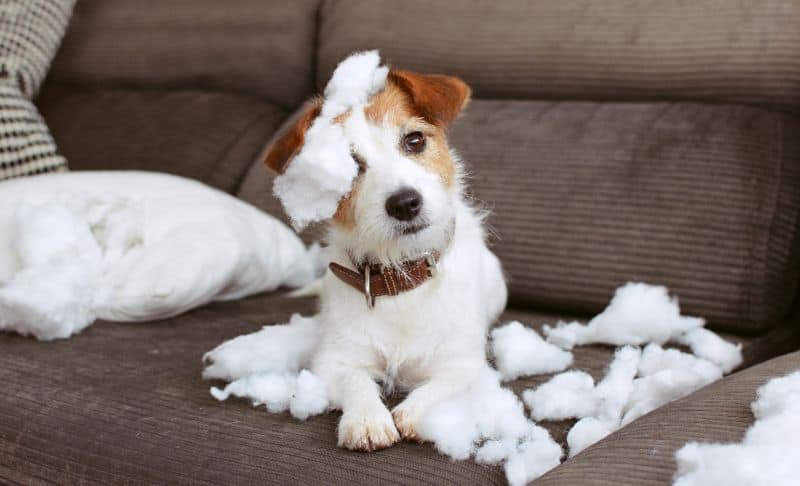Taming the Toy Terrorist: Why Your Dog’s Obsessed with Toy Stuffing

Have you ever spent time carefully and lovingly selecting the perfect adorable toy for your dog, only to come home shortly after to a massacre? Most dogs love toys, but many of them are “toy terrorists”, decimating their beloved belongings for seemingly no reason.
So just why are some dogs obsessed with toy stuffing? Is it dangerous? What can be done?
The Temptation That is Toy Stuffing
It is usually no accident when a dog destroys a toy. In fact most dogs are very methodical about ripping out every last bit of stuffing, locations that blasted squeaker, and shredding the darn thing to pieces.
Your dog isn’t sadistic – hunting toy stuffing is actually a very natural part of being a dog! Most toy destruction is a result of predatory behavior, and is a sign that your dog is tapping into their inner wolf.
While your Pomeranian may not exactly evoke images of a wild animal, it is undeniable that dogs retain some innate instincts. That high-pitched squeak of some toys may be just enough to excite the brain that some hunting is afoot. The result is ripping at the toy until it is “dead”, thus the mess in your living room.
Some dogs may also become destructive as a result of being bored. Dogs who lack mental stimulation and exercise may create their own. This can include toy torture, among other things.
Cautions and Coping
Toy shredding can be messy, expensive, and frustrating. For some pets, though, it can also be potentially dangerous. While our staff at Rocklin Ranch Veterinary Hospital loves to see your pets, we would rather it not be for an emergency visit.
The ripping and shredding of toys itself generally does not hold any harm, but if your pet decides to eat its kill, things can definitely go awry. The innards of dog toys are typically not digestible, and so stuffing, squeakers, and even the outer fabric can certainly pose both choking and foreign body hazards.
Your dog isn’t doomed to a life of no toys, however. There are lots of things a pet parent can do to help keep their pet safe.
- Supervise your pet with new toys until you are sure they are safe.
- Increase your pet’s daily mental and physical exercise.
- Avoid laughing or inadvertently reinforcing your pet’s hunting behaviors.
- Boost mental engagement by choosing puzzle-type toys for your pet to solve.
- Choose toys designed to be indestructible– there are lots of toughly built toys on the market that may work.
- Purchase toys that do not contain stuffing or a squeaker.
- Be sure that any toy you buy does not have small parts attached that can be chewed off.
- Include interactive toys (those that interact with the pet or toys that encourage interaction between you and your pet) in your rotation.
- Remove toys from the rotation if they have signs of damage or compromise.
Of course if your pet does gut a toy, don’t hesitate to contact us right away if you suspect some may have been ingested. While most toy “kills” are harmless, there certainly are some dogs who get themselves into trouble eating the innards of their prey.
Toy terrorists can be challenging, but with some understanding of the behavior, careful toy selection, and close monitoring, you can keep your little wolf safe.

